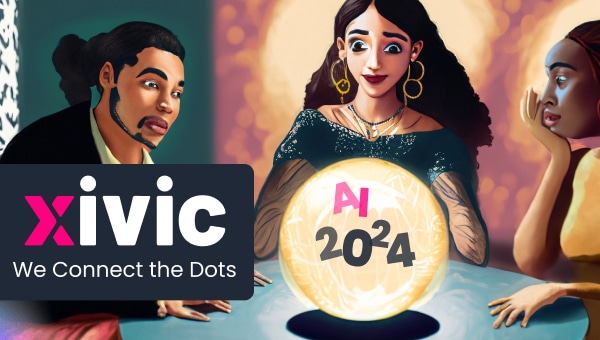We’re no fortune teller, but AI is not the only marketing trend to watch

We’re no fortune teller, but AI is not the only marketing trend to watch
Artificial intelligence (AI) has firmly established its presence in the world of marketing, transforming how data is analyzed, targeting is refined, and personalization is perfected. As we look ahead to 2024, the rise of AI-powered marketing solutions continues, promising even more innovation and adoption. But amidst the AI buzz, it’s crucial to remember that while AI is a force to reckon with, it’s not the sole star in the marketing galaxy.
The marketing and advertising landscape is constantly evolving, and 2024 is shaping up to be a year of major change. Here are three trends that will redefine the way brands engage and connect with their audiences:
1. The importance of first-party data:
As third-party cookies are phased out, first-party data will become increasingly valuable to marketers. Brands that effectively collect and use first-party data will be able to create more personalized and relevant experiences for customers, and to target their advertising more precisely.
First-party data is data that a brand collects directly from its own customers. This data can include things like email addresses, purchase history, and website activity. Brands can use first-party data to create customer profiles, which can then be used to target advertising, personalize marketing messages, and measure the effectiveness of marketing campaigns.
Here are some ways that brands can optimize their use of first-party data:
- Collect first-party data through a variety of channels: Brands can collect first-party data through their website, email marketing, social media, and in-store interactions.
- Use first-party data to create customer profiles: Brands can use first-party data to create detailed customer profiles that include information about their interests, preferences, and buying habits.
- Target advertising based on first-party data: Brands can use first-party data to target advertising to specific groups of customers who are more likely to be interested in their products or services.
- Personalize marketing messages based on first-party data: Brands can use first-party data to personalize marketing messages to each individual customer.
- Measure the effectiveness of marketing campaigns based on first-party data: Brands can use first-party data to measure the effectiveness of their marketing campaigns and track their return on investment (ROI).
By effectively collecting and using first-party data, brands can create more personalized and relevant experiences for customers, target their advertising more precisely, and measure the effectiveness of their marketing campaigns.
Need help integrating first-party data into your marketing strategy? We can help!
2. The boom of social commerce:
Social commerce is an undeniable force, and its momentum is set to surge even further in 2024. Consumers now rely on social media for every step of their buying journey, from initial research to making a purchase and beyond. A mere two-hour live event on TikTok recently achieved what a physical store typically achieves in a week’s worth of sales for a beauty brand. Simultaneously, a captivating Instagram live stream, complete with seamless shopping features, garnered hundreds of thousands of comments. Snapchat’s augmented-reality (AR) lenses empower users to virtually experiment with makeup and share these images with friends.
Social commerce isn’t merely a trend; it’s a formidable force. According to McKinsey, retail social commerce in the US raked in an impressive $56.2 billion in revenue in 2023. Experts anticipate this figure will soar to nearly $80 billion by 2025. Brands can offer rich social commerce experiences by leveraging features such as product tagging, shopping carts, and seamless checkout processes. But it’s not just about driving sales; it’s also a powerful tool for fostering customer relationships and nurturing a sense of community.
In the social commerce landscape, you have the opportunity to connect with a vast audience and streamline the purchasing process by reducing friction in the buyer’s journey. In 2024, brands that wish to engage these consumers must establish a robust social media presence and offer irresistible social commerce experiences.
Not sure where to start? Xivic can integrate your catalog socially.
GET YOUR ECOMMERCE BUSINESS ON SOCIAL
3. The rise of voice marketing:
Voice search and voice assistants are becoming increasingly popular, and this trend is expected to continue in 2024. With more consumers relying on voice-activated technologies to interact with their devices and the online world, marketers need to adjust their strategies to meet this evolving consumer behavior.
Voice-Activated Ads
One way brands can seize this opportunity is by creating voice-activated ads. These ads can be strategically designed to trigger when consumers inquire about specific products or services through their voice assistants. For instance, if someone asks their smart speaker about the best camping gear, a sporting goods brand’s voice-activated ad could provide real-time information and recommendations.
Converting Voice Search
Another aspect that brands should take into account is the optimization of landing page content to cater to voice search. This involves creating content that provides answers to frequently asked questions, employing a conversational tone, and integrating long-tail keywords. By creating voice-optimized content, businesses can improve their visibility in voice search results, driving more traffic to their landing pages and increasing the likelihood of conversions.
Is your brand ready to capture voice traffic?
As the marketing landscape evolves, those who embrace these trends and adapt their strategies will be the ones best positioned to connect with consumers, increase conversions and drive success. The future is here, and it’s an ever-evolving realm where innovation meets opportunity. Is your brand ready to seize it?
Ready to level up your digital transformation?